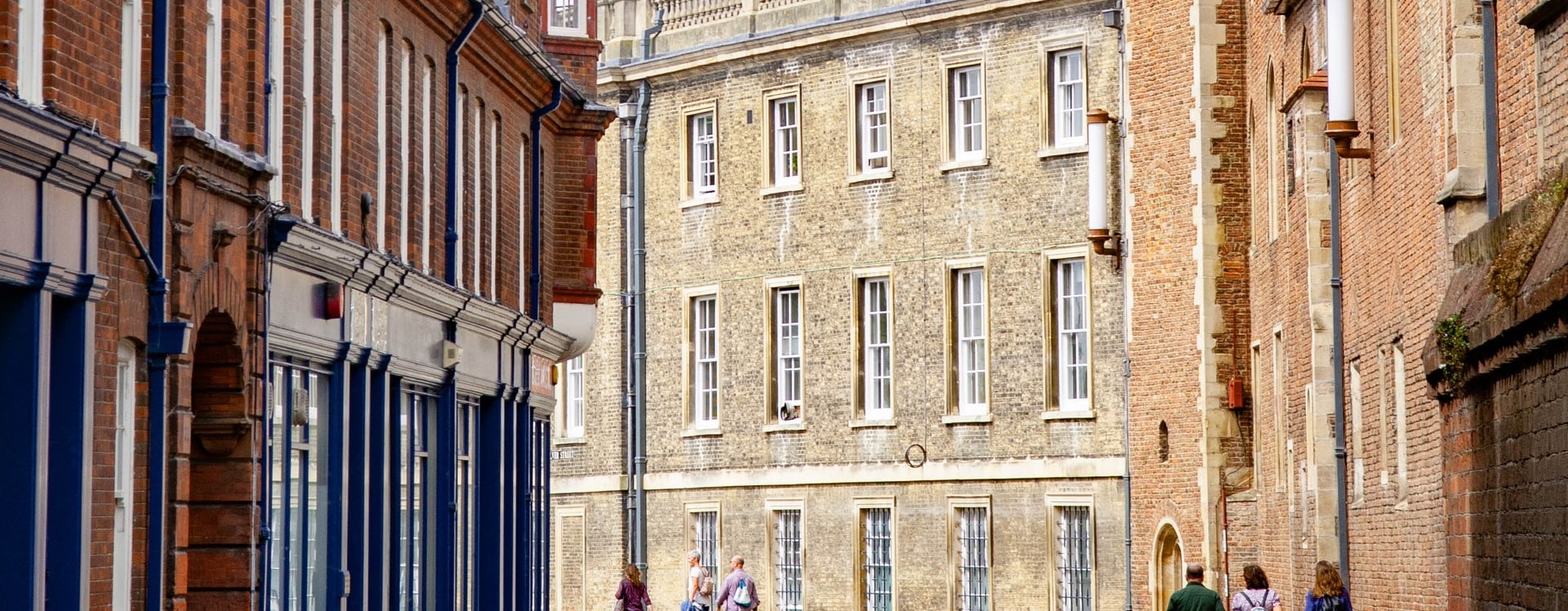Cambridge has a rich and varied history. That much is obvious from the wide variety of period and modern properties that can be found in the city. But how should someone buying a house navigate the Cambridge property market? How does the age of the property affect what buyers should be looking for? Our Cambridge surveyors talk us through what to look out for when buying a property in Cambridge.
The early days
When trying to understand the variety of properties available, it helps to have an idea of the history of Cambridge as a settlement.
Although people had lived in the area previously, it was the Romans who build the first proper settlement at the site of what is now known as the city of Cambridge. Although the Saxons, and subsequently the Normans, also settled in Cambridge, the size of the settlement stayed small right up until the 19th century.
In the early 1800s things started to change. Parliament issued Enclosure Acts, giving a small number of landowners privatised property rights to land that had previously been common. At this point, Cambridge expanded rapidly.
Georgian period
Following the Enclosure Acts, Georgian developments spread south-east from the original city. In the city centre, these usually took the form of tall, thin townhouses with long gardens. These properties were designed to maximise the use of the available space. Larger properties were built further away from the centre.
Our chartered building surveyors have identified several things to look out for when buying a Georgian property:
- Most Georgian houses have basements. These provide great opportunities for basement conversion to gain more space – if this has already been done, it’s prudent to check the integrity of damp-proof tanking. It’s also important to confirm that appropriate consents (such as listed building consent and building regulations) have been obtained for the works. In addition, it’s worth looking at fire standards, and if anything can be done to bring the room as close as possible to the current fire regulation requirements.
- If the basement hasn’t been converted, look out for damp and rotting of floor joists. Ventilation helps to prevent these issues and should be checked.
- The incoming water supply for the house is usually in the basement, so it’s a good place to check that the pipework is not the original lead.
- Rendering of external walls is common in these properties, but can lead to damp when the stone or brickwork underneath expands and contracts, cracking the render.
- Your building surveyor will check for damp, but you can also get an idea of whether damp is present by feeling the walls for moisture or unusually cold temperatures, and looking for tell-tale signs such as flaking paint, peeling wallpaper, mould or staining.
- Damp can also be caused by the ground level outside being raised over the years, resulting in it ending up above internal floor height.
- Sash windows often deteriorate, so it’s wise to check that they are in good shape.
- Extensions to the back of Georgian properties are fairly common, with owners wanting to make the most of the long spaces to the back of the properties. As with basement conversions, check that appropriate consents have been obtained for any works.
- Lastly, look out for signs of active woodworm – woodworm is more likely in any property that has some damp. It can be hard to tell if woodworm is historical or active, but signs like bore dust, woodworm larvae and live or dead beetles are a giveaway.
Victorian period
The railway came to Cambridge in 1845, making travel to London much easier than before. Cambridge became a major trading centre, prompting further expansion. Much of the new housing stock was made up of working-class Victorian terraces; these had very little in the way of ornament and detail. Some larger terraces with bay windows and moulded brickwork were also built for the more wealthy residents. Victorian houses differed from Georgian ones in that they had steeper-pitched roofs and tall, decorative chimneys.
What to look out for:
- Failed brick arches over bay windows indicates that there has been structural movement. When this occurs in these properties, it can be due to shallow foundations.
- The tall roofs means that loft conversions are much more common in these properties than in their Georgian counterparts. As with extensions and basement conversions, confirm that appropriate consents have been obtained for the works. It’s also worth looking at fire standards and fire escape provisions.
- Roof spread is common in these properties, owing to a tendency to cover the original slates with heavier concrete tiles. This can make the roof dish, pushing out the walls and causing cracking and instability.
- Check the integrity of the chimneys – some have started to lean, which can make them dangerous.
20th Century
The next significant period of growth in Cambridge was in the post-WW1 era. 1930s constructions were mostly semi-detached houses designed for small families and retired veterans. They characteristically had very small kitchens, although many have since had their kitchens extended.
- Things to look out for in early 20th century properties:
- Check that any previous structural alterations have been carried out correctly.
- Incorrectly installed cavity wall installation is fairly common in properties of this age.
- Cavity wall tie failure is also frequently seen, because early wall ties were not made from material durable enough to resist corrosion.
- We also frequently see low level single glazing and excessive gaps between stairs and balustrades. These do not conform with modern safety regulations.
Later 20th century properties are more likely to have linked garages and larger kitchen–diners than earlier builds. Because such properties are not as old as the others discussed here, there tend to be fewer issues with them.
However, there are still a couple of things to particularly look out for:
- Flat roofs became a lot more common in this period. Water damage is fairly common with these roofs and they have a limited lifespan. Problems can occur if the guttering drainage is blocked or insufficient, or if dents or dips in the roof form and start to collect water. We have even seen cases where the roof is insufficiently pitched, preventing water drain away. Standing water will damage the roof, eventually leading to leaking and even collapse of the roof.
- Concrete cladding was also often used in this period, and is prone to deterioration, particularly if it is exposed to substantial amounts of water. Any cracks should be sealed up and drainage should be examined carefully to ensure it’s adequate.











